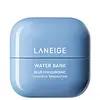What's inside
What's inside
 Key Ingredients
Key Ingredients

 Benefits
Benefits

 Concerns
Concerns

 Ingredients Side-by-side
Ingredients Side-by-side

Water
Skin ConditioningButylene Glycol
HumectantCetearyl Alcohol
EmollientGlycerin
HumectantHydrogenated Poly(C6-14 Olefin)
EmollientDiethylhexyl Succinate
Emollient1,2-Hexanediol
Skin ConditioningGlyceryl Stearate Se
EmulsifyingPhytosteryl/Behenyl/Octyldodecyl Lauroyl Glutamate
Skin ConditioningTriolein
Skin ConditioningGlyceryl Stearate
EmollientSqualane
EmollientMethyl Trimethicone
Skin ConditioningIsononyl Isononanoate
EmollientMyristyl Myristate
EmollientC10-18 Triglycerides
EmollientLactobacillus Ferment Lysate
Skin ConditioningCetearyl Glucoside
EmulsifyingCarbomer
Emulsion StabilisingHydroxyethyl Acrylate/Sodium Acryloyldimethyl Taurate Copolymer
Emulsion StabilisingSodium Stearoyl Glutamate
CleansingTromethamine
BufferingNiacinamide
SmoothingSodium Metaphosphate
BufferingGlyceryl Caprylate
EmollientPropanediol
SolventEthylhexylglycerin
Skin ConditioningCeramide NP
Skin ConditioningParfum
MaskingCaprylyl Glycol
EmollientHydrolyzed Hyaluronic Acid
HumectantSorbitan Isostearate
EmulsifyingSodium Hyaluronate
HumectantDextrin
AbsorbentAsiaticoside
AntioxidantCarthamus Tinctorius Flower Extract
Skin ConditioningMadecassic Acid
Skin ConditioningAsiatic Acid
Skin ConditioningTheobroma Cacao Extract
Skin ConditioningTocopherol
AntioxidantSodium Hyaluronate Crosspolymer
HumectantHyaluronic Acid
HumectantVegetable Oil
Skin ConditioningAdenium Obesum Leaf Cell Extract
MaskingSodium Acetylated Hyaluronate
HumectantAcetyl Tetrapeptide-2
Skin ConditioningUndaria Pinnatifida Extract
Skin ConditioningWater, Butylene Glycol, Cetearyl Alcohol, Glycerin, Hydrogenated Poly(C6-14 Olefin), Diethylhexyl Succinate, 1,2-Hexanediol, Glyceryl Stearate Se, Phytosteryl/Behenyl/Octyldodecyl Lauroyl Glutamate, Triolein, Glyceryl Stearate, Squalane, Methyl Trimethicone, Isononyl Isononanoate, Myristyl Myristate, C10-18 Triglycerides, Lactobacillus Ferment Lysate, Cetearyl Glucoside, Carbomer, Hydroxyethyl Acrylate/Sodium Acryloyldimethyl Taurate Copolymer, Sodium Stearoyl Glutamate, Tromethamine, Niacinamide, Sodium Metaphosphate, Glyceryl Caprylate, Propanediol, Ethylhexylglycerin, Ceramide NP, Parfum, Caprylyl Glycol, Hydrolyzed Hyaluronic Acid, Sorbitan Isostearate, Sodium Hyaluronate, Dextrin, Asiaticoside, Carthamus Tinctorius Flower Extract, Madecassic Acid, Asiatic Acid, Theobroma Cacao Extract, Tocopherol, Sodium Hyaluronate Crosspolymer, Hyaluronic Acid, Vegetable Oil, Adenium Obesum Leaf Cell Extract, Sodium Acetylated Hyaluronate, Acetyl Tetrapeptide-2, Undaria Pinnatifida Extract
Water
Skin ConditioningGlycerin
HumectantDimethicone
EmollientCetearyl Olivate
Sorbitan Olivate
EmulsifyingSodium Hyaluronate
HumectantSerine
MaskingGlycine
BufferingAlanine
MaskingThreonine
Arginine
MaskingProline
Skin ConditioningLysine Hcl
Skin ConditioningGlutamic Acid
HumectantSodium PCA
HumectantPCA
HumectantSodium Lactate
BufferingUrea
BufferingSodium Chloride
MaskingCitric Acid
BufferingBetaine
HumectantAllantoin
Skin ConditioningFructose
HumectantMaltose
MaskingTrehalose
HumectantGlucose
HumectantPentylene Glycol
Skin ConditioningSynthetic Beeswax
Emulsion StabilisingPolyacrylate Crosspolymer-6
Emulsion StabilisingDimethicone Crosspolymer
Emulsion StabilisingDimethiconol
EmollientEthylhexylglycerin
Skin ConditioningCaprylyl Glycol
EmollientSodium Hydroxide
BufferingWater, Glycerin, Dimethicone, Cetearyl Olivate, Sorbitan Olivate, Sodium Hyaluronate, Serine, Glycine, Alanine, Threonine, Arginine, Proline, Lysine Hcl, Glutamic Acid, Sodium PCA, PCA, Sodium Lactate, Urea, Sodium Chloride, Citric Acid, Betaine, Allantoin, Fructose, Maltose, Trehalose, Glucose, Pentylene Glycol, Synthetic Beeswax, Polyacrylate Crosspolymer-6, Dimethicone Crosspolymer, Dimethiconol, Ethylhexylglycerin, Caprylyl Glycol, Sodium Hydroxide
 Reviews
Reviews

Ingredients Explained
These ingredients are found in both products.
Ingredients higher up in an ingredient list are typically present in a larger amount.
Caprylyl Glycol is a humectant and emollient, meaning it attracts and preserves moisture.
It is a common ingredient in many products, especially those designed to hydrate skin. The primary benefits are retaining moisture, skin softening, and promoting a healthy skin barrier.
Though Caprylyl Glycol is an alcohol derived from fatty acids, it is not the kind that can dry out skin.
This ingredient is also used as a preservative to extend the life of products. It has slight antimicrobial properties.
Learn more about Caprylyl GlycolEthylhexylglycerin (we can't pronounce this either) is commonly used as a preservative and skin softener. It is derived from glyceryl.
You might see Ethylhexylglycerin often paired with other preservatives such as phenoxyethanol. Ethylhexylglycerin has been found to increase the effectiveness of these other preservatives.
Glycerin is already naturally found in your skin. It helps moisturize and protect your skin.
A study from 2016 found glycerin to be more effective as a humectant than AHAs and hyaluronic acid.
As a humectant, it helps the skin stay hydrated by pulling moisture to your skin. The low molecular weight of glycerin allows it to pull moisture into the deeper layers of your skin.
Hydrated skin improves your skin barrier; Your skin barrier helps protect against irritants and bacteria.
Glycerin has also been found to have antimicrobial and antiviral properties. Due to these properties, glycerin is often used in wound and burn treatments.
In cosmetics, glycerin is usually derived from plants such as soybean or palm. However, it can also be sourced from animals, such as tallow or animal fat.
This ingredient is organic, colorless, odorless, and non-toxic.
Glycerin is the name for this ingredient in American English. British English uses Glycerol/Glycerine.
Learn more about GlycerinSodium Hyaluronate is hyaluronic acid's salt form. It is commonly derived from the sodium salt of hyaluronic acid.
Like hyaluronic acid, it is great at holding water and acts as a humectant. This makes it a great skin hydrating ingredient.
Sodium Hyaluronate is naturally occurring in our bodies and is mostly found in eye fluid and joints.
These are some other common types of Hyaluronic Acid:
Learn more about Sodium HyaluronateWater. It's the most common cosmetic ingredient of all. You'll usually see it at the top of ingredient lists, meaning that it makes up the largest part of the product.
So why is it so popular? Water most often acts as a solvent - this means that it helps dissolve other ingredients into the formulation.
You'll also recognize water as that liquid we all need to stay alive. If you see this, drink a glass of water. Stay hydrated!
Learn more about Water